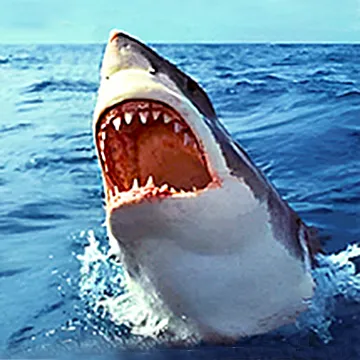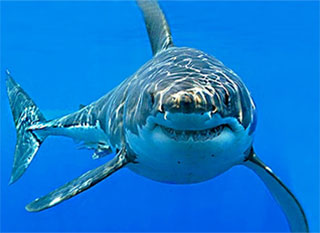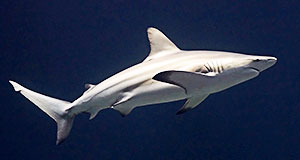Sharks

Contents
Sharks are streamlined hyper-carnivorous predatory fish with cartilaginous skeletons, powerful jaws, sharp teeth, and keen senses. Some, such as the Tiger Shark and Bull Shark, are large, fast, and deadly killing machines. There are over 520 types of sharks, ranging from the massive 18-meter-long Whale Shark to the tiny Dwarf Lantern Shark, which is only 150cm long. Because of their incredibly well-constructed bodies and highly efficient hunting and survival skills, sharks have remained relatively unchanged for over 400 million years.
Shark Description What is a Shark?

Great white shark jaws, mouth and teeth
Sharks belong to a family of fish with a cartilaginous skeleton, two rigid dorsal fins, and five to seven-gill slits. Highly active sharks are sleek and streamlined, while less active ones tend to be fairly flat. Larger and more active sharks cruise and hunt in the upper and middle depths of the oceans, while smaller ones tend to stay near the seafloor. The scientific name for sharks is Chondrichthyes elasmobranchs.
Sharks don't have a skeleton; instead, they have thick skin composed of tough but flexible interwoven fibres made of cartilage (the same kind of stuff that our noses and ears are made of). These fibres form a solid tube-like framework onto which all its muscles and organs are attached. You can think of a shark's skeleton as being similar to the composite skin of an airplane. One advantage of a cartilaginous skeleton is that it is much lighter than an equivalent bony skeleton.
Sharks don't have a skeleton; instead, they have thick skin composed of tough but flexible interwoven fibres made of cartilage (the same kind of stuff that our noses and ears are made of). These fibres form a solid tube-like framework onto which all its muscles and organs are attached. You can think of a shark's skeleton as being similar to the composite skin of an airplane. One advantage of a cartilaginous skeleton is that it is much lighter than an equivalent bony skeleton.
Sharks are unique among most fish because they do not have a gas-filled swim-bladder to control their buoyancy. Instead, they rely on large oil-rich livers and their light cartilaginous skeleton to maintain buoyancy. However, these traits alone are not sufficient to keep the shark buoyant, and they would sink to the bottom if they stopped swimming. Sharks counter this sinking tendency by constantly swimming forward—a bit like how an airplane stays aloft by getting a dynamic lift by moving through the air.
Photo: Shark skin
Sharks do not have overlapping scales like other fish. Instead, they have very rough skin made up of thousands of tiny, tooth-like scales called "dermal denticles." When rubbed in a forward direction, these denticles feel very rough, but they flatten and smoothen in a backward direction, reducing hydrodynamic drag. This makes swimming more efficient and quieter for sharks compared to bony fish. In the past, dried shark skin was used as sandpaper and for non-slip hand-grips on swords.
Photo: Great white shark teeth
Some sharks have multiple rows of teeth, which they continuously lose and replace. These rows of teeth grow inside the jaw and are gradually pushed forward to replace those in front that may be worn or lost. Some sharks can grow as many as 35,000 teeth in their lifetime. The shape of the teeth is related to the shark's diet. Sharks that feed on molluscs and crustaceans have dense and flattened crushing teeth. Those that feed on fish have needle-like gripping teeth. Sharks that feed on large mammals have pointed lower teeth for grabbing and triangular serrated upper teeth for cutting. Plankton-feeders have small non-functional teeth.
Sharks have an unusual dislocatable jaw structure. While most animals have a firmly attached upper jaw and a hinged lower jaw, sharks have a special biting unit formed by both the upper and lower jaws that sit beneath the skull. When a shark attacks its prey, it thrusts its mouth, consisting of this special biting unit, forward to grab its prey. All sharks are capable of this, but it is most noticeable in species like the great white shark. This terrifying extended mouth with razor-sharp teeth is what most people think of when they imagine a shark.
Sharks have eyelids but they do not blink because the surrounding water cleans their eyes. Some sharks have a nictitating membrane, which is like a third eyelid, to protect their eyes while hunting. For example, the great white shark can roll its eyes backwards to protect them when attacking prey. Sharks have excellent eyesight and can identify objects by the contrast they make to their background. Unlike bony fish, sharks can dilate and contract their pupils.
Sharks have an excellent sense of smell. Some specifies can detect blood in seawater in quantities as low as one part per million.
Sharks have a small opening on the sides of their heads that lead to their inner ear. It is not certain exactly how well they can hear.
Sharks have numerous electroreceptors called ampullae of Lorenzini around its head. These receptors are the most sensitive of any animal. They can detect the electromagnetic fields produced by animals in the sea. They also use these sensors to detect the earth's magnetic field and use this for orientation and navigation. Sharks can also detect vibrations in water with their Lateral line, which runs the length of their bodies.
Shark Habitat Where Do Sharks Live?
Photo: Shark swimming
Sharks inhabit a wide range of ocean environments, from tropical to temperate zones, and can be found in shallow coastal waters as well as the deepest and coldest parts of the open seas, reaching depths of about 2,000 meters. Larger sharks are capable of traveling up to 80 kilometres per day in search of food. Most sharks are bottom dwellers, residing just above the seabed. Additionally, some are found nearer to shore and also inhabit river estuaries. A few species, such as the endangered Northern River shark and spear-tooth shark, can be found in freshwater rivers.
Shark Diet What Do Sharks Eat?
Photo: Shark airborne to catch its prey
Sharks are carnivores, and each species has its own food preferences depending on its lifestyle and habitat. They usually feed in the evenings and at night.
The great white shark's diet includes sea lions, dolphins, turtles, small whales, other sharks, and even sea birds. It usually attacks its prey from below and strikes so fast that most of its victims have little time to react. Smaller prey is bitten and swallowed whole, while larger prey is ripped apart into smaller pieces so they can be swallowed.
Photo: A shark herding fish
Sharks that feed on other fish, including other sharks, have long needle-like gripping teeth, well suited for catching small fish. The shake kills its prey by biting it and swallowing the fish whole.
Photo: Whale Shark - filter feeder
The largest sharks, such as the whale shark, are filter-feeders. They strain small fishes, krill, larvae, and other types of plankton out of the water and eat huge quantities of tiny animals. Filter feeders have tiny, non-functional teeth.
Bottom-feeders, are usually rather small and scurry along the ocean floor. These sharks usually feed on molluscs, crustaceans, bottom fishes and invertebrates such as lobsters, crabs, snails, octopuses, squids and various echinoderms. They have large, strong, slab-like teeth that make cracking open shells easier. For example, the Port Jackson shark has two types of teeth to process its food: the front teeth are pointed for grasping prey, and the back teeth are flat and molar-like for crushing hard shells.
How Sharks Swim Why are Sharks Like Airplanes?
Photo: How a shark swims
Sharks swim through water in a manner very similar to how airplanes fly through the air. Both airplanes and sharks would fall to the ground (ocean floor in the case of a shark) if they did not keep moving through their medium, as they require dynamic lift to stay afloat.
The shark's front pectoral fins act in a similar fashion to an airplane's wings, providing lift. Dynamic lift is only provided when an appropriately shaped object is moving through its medium. In the case of an airplane, this is provided by its engines, which thrust the plane forward, and the wings provide the necessary lift. In the case of the shark, its powerful tail provides it with forward motion, and its front fins provide the necessary lift. When the shark tilts its fins upwards, it can rise. When it tilts them downwards, it can dive. An airplane accomplishes the same outcome using the flaps on its wings. A shark has to keep moving constantly to stay floating at a desired depth. The vertical dorsal fins on its back act as rudders and, together with adjustments it makes to its pectoral fins, steer the shark through the water.
Shark Reproduction Three Main Forms of Reproduction
All sharks practise internal fertilisation, where the male inserts a clasper into the female’s cloaca and releases sperm. Once fertilised, the development of the young follows one of three modes of reproduction. The gestation periods of various sharks aren't fully known. It is thought that it ranges from several months to as long as two years.
Some sharks lay eggs encased in a tough leathery eggcase. These eggs have unique attachment mechanisms such as sticky mucus filaments, tendrils and horns to assist them in fixing themselves to the seabed, reefs or seaweed. The Port Jackson shark even lays spiral-shaped eggs that wedge themselves in crevices, etc. These eggs can take between 6-9 months to hatch, at which time a miniature version of an adult emerges from the egg.
Another group of sharks have the embryos develop inside eggs that remain in the mother's body until they are ready to hatch. Once the baby sharks hatch inside their mother, she will then give birth to the live young.
In viviparity reproduction, a baby shark receives nutrients and oxygen through an umbilical cord and develops inside its mother, similar to placental mammals.
Some sharks have up to 100 pups at a time, while others may have as few as two or three. As soon as shark pups are hatched or born, they swim away and live independent lives.
Shark Life Cycle What Kills Sharks?

Photo: Shark swimming
Each shark species has its own unique life cycle. Broadly speaking, most sharks live for 20-30 years. Some can live for as long as a hundred years. Because of their slow reproductive rates, the length of time for them to reach sexual maturity and their longevity, sharks are very susceptible to population depletion.
Shark Threats and Predators What Kills Sharks?
Large adult sharks are apex predators and have few natural enemies. However killer whales (Orcas) have been known to prey on these sharks. Shark eggs and juvenile sharks fall prey to many predators larger than themselves.
Humans are the greatest threat to shark populations. Up to 100 million sharks are killed each year due to commercial and recreational fishing. Flake, frequently used to make fish and chips, is actually the flesh of several different species of small shark.
A cruel human practice is called finning. Here fishermen capture live sharks, cut off their fins, and dump the finless animal back into the water. The resulting immobile shark dies a cruel death from suffocation or is eaten by predators.
Shark Conservation Status Are Sharks Endangered?
Commercial and recreational shark fishing is allowed. But due to the significant decline in their numbers, the following shark species are protected in Australia:
CRITICAL: Grey Nurse Shark and Speartooth Shark
ENDANGERED: Northern River Shark
VULNERABLE: Grey Nurse Shark, Whale Shark, White Shark, Dwarf Sawfish, Queensland Sawfish, Freshwater Sawfish, Green Sawfish, Dindagubba, Narrowsnout Sawfish
Shark Attacks Are sharks Dangerous?
Shark Attack Video
Video: Excellent video about shark attacks
Four species of sharks responsible for most shark attacks on humans. They are the White, Tiger, Bull and Whaler sharks.
Sharks don’t find humans tasty. Unfortunately, humans venture into their territory and are often mistaken for prey. Most people are bitten only once and released. This suggests that the shark releases the person as soon as it realises that it doesn't taste like its usual prey and abandons the bite, but this could still cost you an arm or leg or death from bleeding.
25 Shark Facts
- Sharks range in size from the massive 18m whale shark to the 20cm dwarf lanterns-hark.
- There are over 520 species of shark living in the the world's oceans.
- Most sharks are harmless and don't hunt humans.
- Only four sharks have been known to attack humans.
- These are the great white, oceanic white-tip, tiger, and bull sharks.
- Bull sharks are the most aggressive.
- You are four times more likely to die from bumping into another person than by bumping into a shark.
- Shark attacks on humans are usually a case of mistaken identity. The shark has mistaken a human for a seal or turtle.
- They don't like the taste of human flesh.
- Sharks have sandpaper-like skin.
- They have no bones. Instead they have thick cartilaginous skin that acts as a skeleton.
- Cartilage is the same stuff our nose & ears are made of.
- Unlike other fish, sharks lack swim-bladder to keep them afloat.
- They have to swim continuously to stay from sinking.
- Sharks lose and replace their teeth continuously.
- A shark can replace up to 35,000 teeth in its lifetime.
- The shortfin mako is the fastest shark. It can swim at up to 50 kph.
- Some sharks 'sleep swim' to keep water flowing over their gills so they can breathe.
- Females of some shark species can reproduce without a male to fertilise their eggs.
- Dried shark skin was once used as sandpaper and for non-slip hand-grips for swords
- Some sharks, if inverted or stroked on the nose, go into a trance and are paralysed.
- Not all sharks live in the sea. Some live in large freshwater rivers.
- Fish and chips shops sell "flake", which is shark meat.
- Sharks were on the earth 300 million years before the dinosaurs.
- Many species of sharks are threatened with extinction.
All Rights Reserved. (Last Updated: Aug 20, 2024)